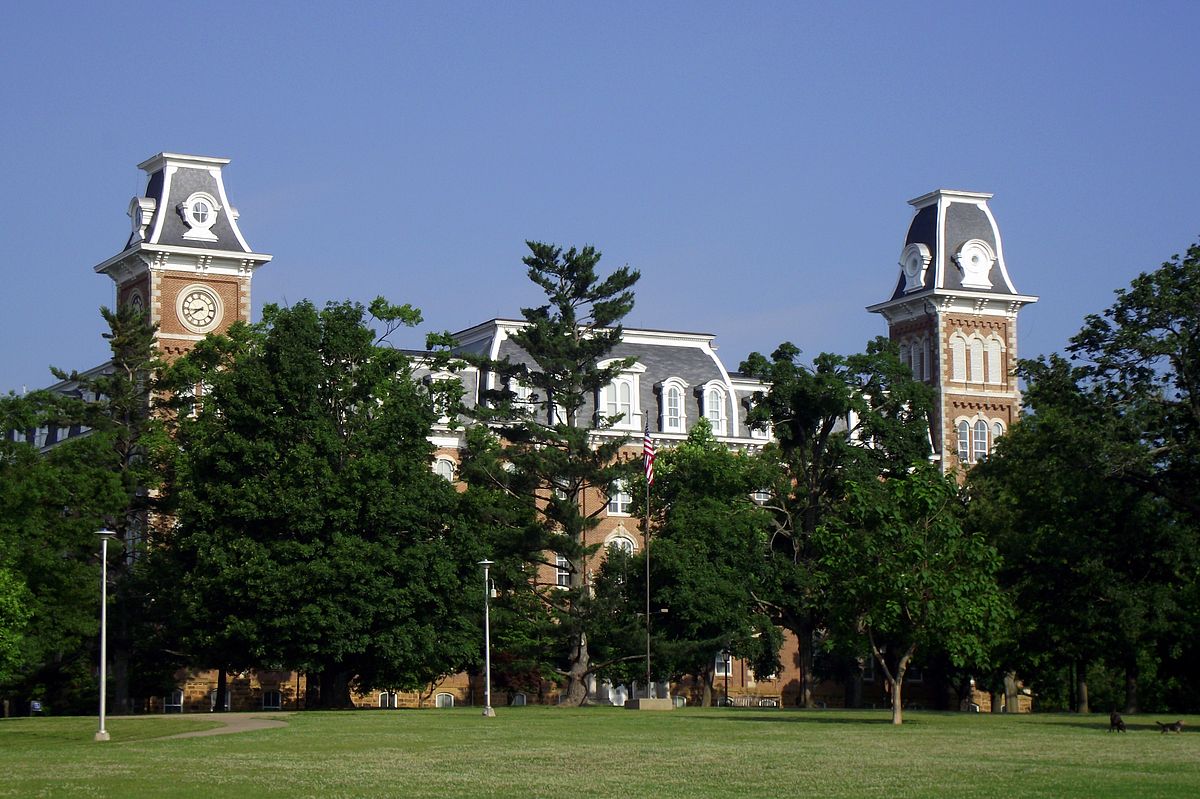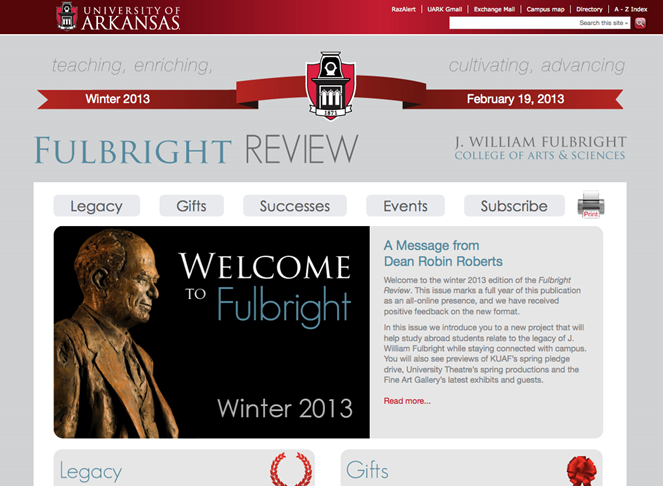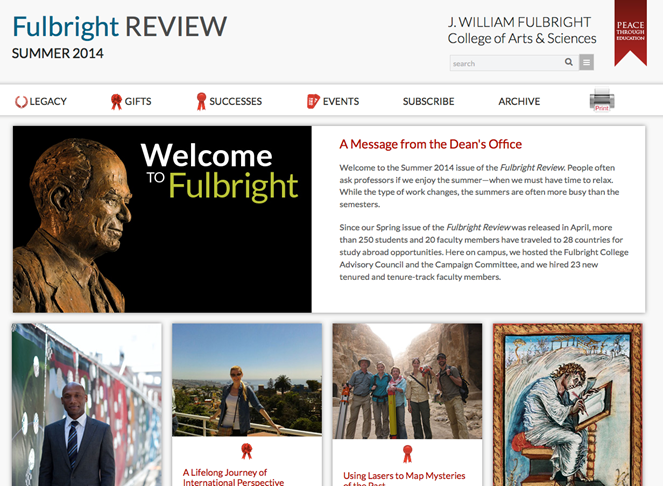About University of Arkansas Fulbright College
The Fulbright College of Arts and Sciences is the largest and most diverse college on the University of Arkansas campus, with more than 7,700 students across 19 academic departments. The college, named after former University President and United States Senator J. William Fulbright, offers degrees in the fine arts, humanities, natural sciences, and social sciences.

Fulbright College's quarterly publication, Fulbright Review, was previously a print piece mailed to over 25,000 subscribers, primarily alumni and donors. While the publication was visually appealing and gave readers a tangible experience, the production cost was expensive, requiring $14,500 to design, print, and mail each issue.
In addition, content errors caught after printing thousands of copies could not be edited, and measuring readership was nearly impossible. The declining popularity of print media in favor of being eco-friendly, along with the limitations of sharing physical issues, further pushed Fulbright College to take the publication online.
The high cost of print publications and the desire to be eco-friendly pushed Fulbright College to take their publication online.
Choosing the Right Solution
Fulbright College looked into three options for an electronic publication: flipbooks, PDF magazines, and website publications. After considering the available campus resources and the pros and cons of each option, Fulbright College was able to eliminate all but one.
Flipbooks, which have a similar look and feel to print publications, would only remove the need to print and mail. The same lengthy and expensive building process, including outsourcing the design, would still be required before exporting the publication as a PDF for flipbook creation. Furthermore, Fulbright College wanted the publication to be ADA compliant and search-engine friendly, but flipbooks, typically being Flash- or image-based, could not meet those requirements.
PDF magazines alone would not be a suitable fit either. Although they are a good supplement and can be helpful to alleviate the issue of an older demographic, large file sizes and image compression can reduce PDF and publication quality, something Fulbright College did not want to sacrifice.
An accessible and SEO-friendly website publication emerged as the best option, offering Fulbright College many more benefits than drawbacks. Although website publications inevitably have less design flexibility and more competition for capturing reader attention, they allow content creators to edit with ease, readers to access and share articles through the web, and the publication team to improve topics based on instant feedback from visitor comments and analytics. Plus, the solution would save Fulbright College $58,000 per year in design, print, and mail costs.
A website publication would save Fulbright College $58,000 per year.
From Print to Web
In April of 2012, prior to migrating to the Modern Campus CMS content management solution, Fulbright College released its electronic publication for the first time. The publication existed as a website, complete with navigation, images, subscription forms, archives, PDFs, and analytics. However, the publication design fell short. Each issue was created with Dreamweaver using an 1140 pixel grid system, which required content boxes to be equal in size rather than allowing the boxes to expand with images and text as desired. The creation process also required a lot of manual labor and was not as efficient as possible, taking an average of 20 hours per issue.
Fulbright Review received an upgrade in 2014 when the Fulbright College websites were migrated into Modern Campus CMS. Motivated by new university website guidelines and an improvement in mobile-friendly frameworks, the college set a redesign in motion. Fulbright College switched the website to a masonry-style layout, a flexible layout that allows content boxes to have variable heights, and then lightened the look and feel of the design.
 Fulbright Review Initial Design
Fulbright Review Initial Design
Fulbright Review Redesign
Modern Campus helped build templates based on this design in order to automate the process of creating an issue. In addition, the tree file structure utilized by Modern Campus CMS allowed Fulbright College to develop a straightforward system for creating and publishing new issues. Each issue's main folder contains four subfolders for the primary categories of the publication: Legacy, Gifts, Successes, and Events. Articles are added to the relevant folders and, once published, are dynamically generated to appear on the publication main page and appropriate article listing pages. Modern Campus CMS also provides the ability to generate a PDF for the entire issue, saving Fulbright College from manually creating one using InDesign as in the past. The automated processes have cut creation time in half, allowing an issue to be put together in only 10 hours.
The automated processes have cut creation time in half, allowing an issue to be put together in only 10 hours.
To improve the reader experience, a number of new features were added in addition to features from the previous design. Visitors gained the ability to browse images that link to corresponding articles, share stories through email and social media, view related content, filter stories using tags, and quickly jump to the next article in a category. Fulbright Review was also cleanly integrated into the college home page to expand and increase readership.
A Publication for the Readers
Fulbright Review managed online with Modern Campus CMS has given Fulbright College the power and freedom to focus on the interests of readers. Every story incorporates a key message of the college, including internationalism, faculty research, visual and performing arts, STEM, and diversity. Fulbright College continues to gain a better understanding about the types of stories visitors would like to read with the help of analytics integrated into the CMS. Moreover, since moving online, the publication has gained unlimited exposure possibilities and is reaching new audiences. Issues are distributed to subscribers via email, and analytics indicate that social media and the college home page also regularly draw visitors to the publication website.

Tackle your biggest challenges
